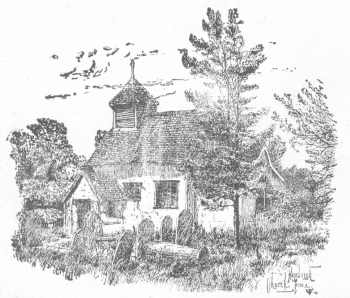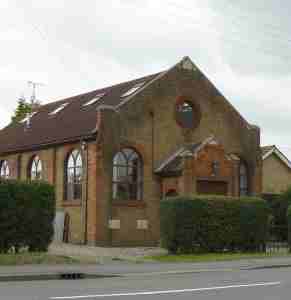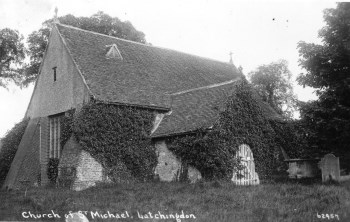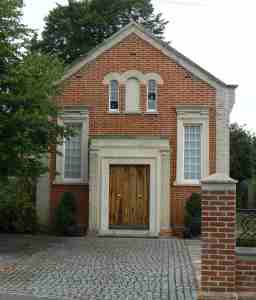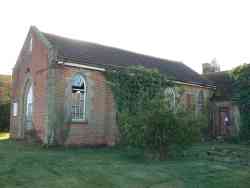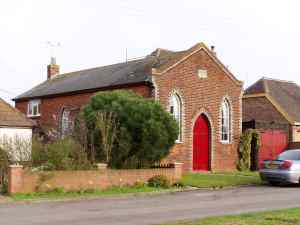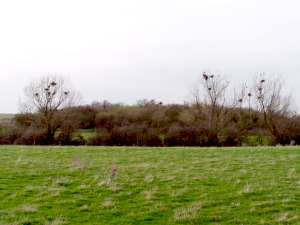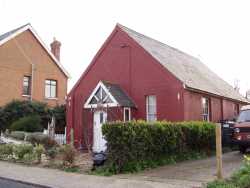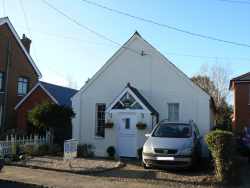Churches or Chapels no longer in use
|
Ever since St Cedd built his chapel
in AD654 churches have been erected throughout the area. Some churches fell into disrepair and have been demolished or had their materials used to build a new church.
Other churches such as Woodham
Mortimer have been constructed on the site of an earlier
church. Listed below are details of some of the ruined churches.
Althorne- Primitive Methodist Chapel Built in 1859 the chapel suffered from declining congregations and is now a house.
Althorne- Particular Baptist Chapel Built in 1859 disused about 1930 Bradwell on Sea - Primitive Methodist Chapel Built at Waterside in 1863 disused about 1950 Burnham on Crouch - Congregational Chapel Built in 1862 at Chapel Road Destroyed by fire in 1946 Burnham on Crouch - Primitive Methodist Chapel The Primitive Methodists had a chapel in Albert Road which was closed in 1984 when the Methodist congregation joined the URC and used their church in Station Road. The chapel was nicknamed the four of diamonds after the pattern on its wall. Today the Chapel is used as a house.
Burnham on Crouch - Wesleyan Methodist Chapel Built in 1842 Burnham on Crouch - Strict and Particular Baptist Built in 1751 disused about 1930 Burnham on Crouch - Marsh Mission Mission hall - next to Redward Cottages, Burnham marshes- This was used as extra accommodation at Burnham URC church but was demolished recently Burnham on Crouch - Salvation Army Salvation Army Citadel - Station Road - This is now the site of Tesco's car park
Hazeleigh - St
Nicholas
The church was sited next to Old Hall at Hazeleigh Hall Lane, Hazeleigh. There is some doubt about the date that it was built although parish registers date back to 1575. There is mention of a Rector in 1390 although this may have referred to a chapel on the site, which would have been attached to Woodham Mortimer Church. Construction was of lathe and plaster over a timber frame although the church was small in size. The church was unusual in that it stood next to Hazeleigh Hall and both buildings were enclosed by a moat. By the late 19th century a new iron chapel had been erected in the populated part of Hazeleigh, which left the isolated church with a dwindling congregation. By 1900 the church was declared as dilapidated beyond repair having sunk to the south and west sides causing internal problems. The last service was held in 1906 and a public meeting in 1923 agreed to demolish the church.
The new iron church was also
demolished and the responsibility adopted by Woodham
Mortimer Church. The site is now covered by woodland although a few headstones are still to be seen. In 1915 George Worley described the church in his Dictionary of the County- The older of the existing churches (St Nicholas) is an insignificant building of timber and plaster erected early in the eighteenth century in place of the original parish church, some relics of which have been retained. These include the tombs of the Alleyne family, resident at the adjacent hall in the sixteenth century. The church is now only used for burial services, another (of iron) having been erected in 1893 for public worship. Registers start from 1575.
Latchingdon - Lawling Chapel Archbishop Lafrane founded a chapel in the late 11th century near to Lawling Hall , Latchingdon. The chapel was believed to have been ruined before 1650. Latchingdon Congregational Chapel Built in 1908 now a house
Latchingdon - St Michaels Church
St Michael's Church was built in 1618 and used as the parish church for Snoreham and Latchingdon. About 1820 the Church tower collapsed and was replaced by a wooden weather boards. It's poor condition and the development of the main village a few miles away in the 1800's led to the building of a new church in the village in 1898 and the subsequent closure of this church. The Church still stands although it has been converted into a private house although the adjoining graveyard still is in use. Please note that although there is public access to the churchyard there is no public access to the old church. For memorials in this old church visit the main page for Latchingdon Church
Mayland - The original church was sited at Mayland Hill about 100 yards from the present church.
The date of building is unknown
although the church bell has been dated as 1662, church
plate as 1568 and the surviving parish registers start
at 1748.
Few records survive although it is
known that the church was wooden framed with a shingle
spire and three bells.
The church was demolished with the
approval of the Bishop of Rochester in 1873 with the
material sold to builders.
By 1867 the new church was erected
nearly. The site is now part of private land although some headstones can be seen from the roadside. Purleigh Congregational Chapel Built in 1821 now a house Purleigh Primitive Methodist Chapel Built in 1929
Snoreham (Latchingdon) Snoreham was a parish which was later combined with Latchingdon.
The church was erected by the Grey
Family in the 14th century on land next to Snoreham
Hall. in Rectory Road, Latchingdon.
The church quickly deteriorated and
by the mid 1700's was beyond use and used as part of the
farming at Snoreham Hall. For many years a sermon was preached from under a tree near the spot where the pulpit and altar stood although this was discontinued by the twentieth century. Southminster - Particular Baptist Chapel Built in 1861 - Now used as a house
Steeple - Congregational Chapel Built in 1857 - Now converted to housing
Steeple -
Peculiar Peoples Chapel The chapel was erected in 1877 at a time that strict religion was attracting large congregations. By the mid 1900's the congregation dwindled and in the mid 1950's the chapel was sold for housing.
Steeple - St Lawrence and All
Saints
A church stood on the site next to
Steeple Hall since Saxon times.
The date of the church is not known
although material taken from the ruins has been dated as
12th and 14th centuries.
The church deteriorated over a long
period with damage reported as early as 1564. The church
continued in use until 1882 when the building was
demolished and much of the material used in construction
of the current church in the Street, Steeple. The church was a small single storey building with a porch to the south.
Stansgate Abbey Founded before 1121 by Radulf Filius Brientii as a Cluniac Priory The Abbey was dedicated to St Mary Magdalen and served as parish church for Steeple until its closure in 1524 when Stansgate fell victim to politics as Cardinal Wolseley obtained a papal bull closing a number of religious houses including Stansgate.The last remains were demolished in 1922.. Tillingham - Original Peculiar Peoples Chapel Built as a Tansleyite Chapel in 1897 during a split in the Church but when reconciled in 1913 the chapel closed and is now a house
Tillingham- Independent Chapel Originally an independent Chapel but was also used as a Congregational Chapel
Tillingham- Particular Baptist Chapel Built 1830 disused 1892 Tillingham- Primitive Methodist Chapel Built 1811 disused about 1930
Woodham Walter - Congregational Chapel Built in 1881 - Now used as business premises
Woodham Walter -
St Michael T he church was sited inside the moat of the Old Hall.
The first mention of the old church
was of building work carried out in 1454.
The new church was built in 1564
although the reason that the old church was disused is
not known - it may have been damage, it may have been no
longer convenient for the population or it may just have
been a nuisance to the occupant of Old Hall. In the late 17th century the Old Hall was in turn demolished leaving no trace of either building today. |



